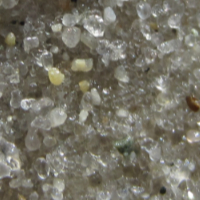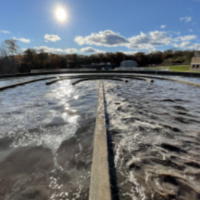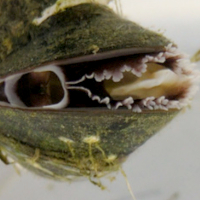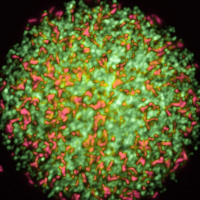
Microplastics
Plastic contamination in the environment is persistent and widespread, with many environmental plastics occurring as microplastics (fibers and fragments of plastics less than 5 mm in size). About half of microplastics are estimated to have entered the environment after passing through a wastewater treatment plant; the other half are produced in the environment by weathering and fragmentation of mismanaged macroplastics. While there are many types of plastics, this work focuses is on polyethylene (PE) and polyethylene terephthalate (PET) because they are major microplastic contaminants of aquatic ecosystems. Both PE and PET are commonly used as packaging materials, where bottles for milk and laundry detergents are often made from high density PE, plastic wrap is made from low density PE, and water bottles and soft drink bottles are often made from PET. PET and PE are key polymers confronting wastewater treatment plants and are both known to be highly recalcitrant to biodegradation. These polymers were thus selected to serve as a real-world test for developing our technology.

Waste water treatment
This project will be built on our extensive knowledge of filter feeding processes in bivalves. We will explore the feasibility of using freshwater mussels in a tertiary wastewater treatment system to achieve > 90% microplastics (MPs) removal at pilot-scale continuous system. Dr. Baikun Li will lead students for this pilot-scale study at the University of Connecticut Water Control Facility over 1-year period. Dr. Evan Ward’s group will provide dreissenid mussels for the pilot-scale system. Mass balance of MPs throughout the UConn Water Control Facility and the pilot-scale system will be established, and MP removal models will be developed to fundamentally understanding MP concentration, separation and degradation. Along with MP measurement, general wastewater quality parameters (e.g., pH, conductivity, ammonium, nitrate) along the pilot-scale system will be real-time monitored using mm-sized electrode arrays (MEAs) that Dr. Li’s group has developed. Such information will elevate the understanding of the impacts of wastewater quality on MP removal efficiency. Furthermore, advance treatment of bioseparated MPs in a follow-up Fenton system will also be studied to determine the feasibility of complete MP removal. This project will also determine the impact of MPs on other emerging contaminants in wastewater (e.g., heavy metals, organic carbon and pathogens) and their correlation with wastewater-based epidemiology (WBE).

Bivalves: concentrating microplastics
This project will take inspiration from nature and employ freshwater mussels to quickly and efficiently remove > 90% of MP at waste-water-treatment-plant scales. Dreissenid mussels process large volumes of water and can capture a myriad of suspended MP particles down to 1 µm with high efficiency. These animals are prolific breeders and have life cycles that are much less complex than other freshwater bivalves, allowing them to be cultured in the laboratory. Additionally, zebra and quagga mussels can grow at high population densities and produce copious amounts of pseudofeces and feces containing MP particles. During the process of removing MP from the water and producing biodeposits, mussels will combine MP particles with plastic-degrading bacteria, transforming the plastics into naturally occurring organic molecules. Mussels have been used previously in engineering solutions to manage water quality and to remove pharmaceuticals and heavy metals from wastewater effluent.

Plastic degrading bacteria
Biochemical pathways exist to depolymerize most common plastics and microplastics (MPs). However, these natural degradation rates are too slow to solve the environmental MP contamination problems. One reason for this is that in the environment, MPs are very dilute: even in urban estuaries typical concentrations range from 10-1000 MP/m3. Becausereactions are always slow where reactants seldom meet, our strategy is to take advantage of the rate enhancement from dramatically co-concentrating MPs and plastic-degrading bacteria. We will use our microbial collection of over 1000 bacterial strains gathered from open ocean, coastal and estuarine plastic debris samples to find high-function plastic-degrading bacteria. A new collection of fresh-water plastic-degrading bacteria will also be established. In addition, a variety of test MP types will be custom synthesized with 13C heavy carbon allowing us to track the extent of MP degradation and the molecules into which MPs are converted. We will mussels’ natural water-filtration capabilities to co-concentrate MPs and plastic-degrading bacteria in order to enhance MP degradation. Also, we will develop and test a reduced-volume, microbially-driven, Fenton reactor designed to enhance degradation of the concentrated MPs

Adoption of new technologies
Innovation and resilience in the wastewater sector are crucial for confronting growing challenges including how to deal with emerging contaminants like microplastics. Yet, we do not fully understand what drives (or impedes) innovation in this context. We theorize innovation depends on interactions between state governance, wastewater treatment systems and the nature of the innovation itself. States play a key role in this context given their authority to implement and enforce the Clean Water Act (CWA) aimed at improving water quality in U.S. waters; but how states use this authority to foster innovation that can improve treatment effectiveness of heretofore unregulated contaminants remains unclear. Part of the answer may lie in how state agencies govern through balancing principles of “adaptive” or “conventional” governance, and how the regulatory environment that they create can shape a more (or less) supportive space for innovation. Part of the answer may also lie in the nature of the innovation (level of complexity, ease of adoption), how innovation diffuses in this highly regulated environment, and the role and characteristics of wastewater systems that foster (or constrain) innovation adoption. Research funded by this NSF EFRI project will help us fill these fundamental knowledge gaps and ultimately contribute practical guidance to foster innovation and enhance resilience in the U.S. wastewater sector.

Putting it all togther
Through co-concentrating MPs and MP-degrading bacteria using bivalves we hope to offer an innovative, sustainable, bio-inspired strategy to remove and depolymerize recalcitrant end-of-life MPs from water. Adoption new innovations in real-life requires more than a proof of concept and experimental evidence that the new technology is sound (e.g., effective, reliable, sustainable, economical, etc.). Not only will we invent and develop new technology, but we will also quantify drivers and barriers to technology adoption and evaluate strategies for increasing MP treatment technology uptake at water treatment facilities. Our project has these three goals:
- Goal 1: Enhance depolymerization of end-of-life microplastics by bacteria following co-concentration by filter feeding organisms.
- Goal 2: Develop an optimal water treatment process for MP separation and elimination by integrating filter-feeding bivalves with plastic-depolymerizing bacteria.
- Goal 3: Integrate and this technology as a transformative innovation in wastewater systems and develop novel methods to both quantify both the drivers and the barriers that will impact implementation of these new technologies.